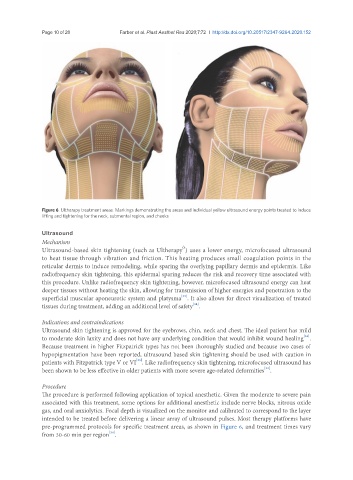Page 860 - Read Online
P. 860
Page 10 of 28 Farber et al. Plast Aesthet Res 2020;7:72 I http://dx.doi.org/10.20517/2347-9264.2020.152
Figure 6. Ultherapy treatment areas. Markings demonstrating the areas and individual yellow ultrasound energy points treated to induce
lifting and tightening for the neck, submental region, and cheeks
Ultrasound
Mechanism
Ò
Ultrasound-based skin tightening (such as Ultherapy ) uses a lower energy, microfocused ultrasound
to heat tissue through vibration and friction. This heating produces small coagulation points in the
reticular dermis to induce remodeling, while sparing the overlying papillary dermis and epidermis. Like
radiofrequency skin tightening, this epidermal sparing reduces the risk and recovery time associated with
this procedure. Unlike radiofrequency skin tightening, however, microfocused ultrasound energy can heat
deeper tissues without heating the skin, allowing for transmission of higher energies and penetration to the
[33]
superficial muscular aponeurotic system and platysma . It also allows for direct visualization of treated
[34]
tissues during treatment, adding an additional level of safety .
Indications and contraindications
Ultrasound skin tightening is approved for the eyebrows, chin, neck and chest. The ideal patient has mild
[34]
to moderate skin laxity and does not have any underlying condition that would inhibit wound healing .
Because treatment in higher Fitzpatrick types has not been thoroughly studied and because two cases of
hypopigmentation have been reported, ultrasound based skin tightening should be used with caution in
[35]
patients with Fitzpatrick type V or VI . Like radiofrequency skin tightening, microfocused ultrasound has
[33]
been shown to be less effective in older patients with more severe age-related deformities .
Procedure
The procedure is performed following application of topical anesthetic. Given the moderate to severe pain
associated with this treatment, some options for additional anesthetic include nerve blocks, nitrous oxide
gas, and oral anxiolytics. Focal depth is visualized on the monitor and calibrated to correspond to the layer
intended to be treated before delivering a linear array of ultrasound pulses. Most therapy platforms have
pre-programmed protocols for specific treatment areas, as shown in Figure 6, and treatment times vary
[34]
from 30-60 min per region .

